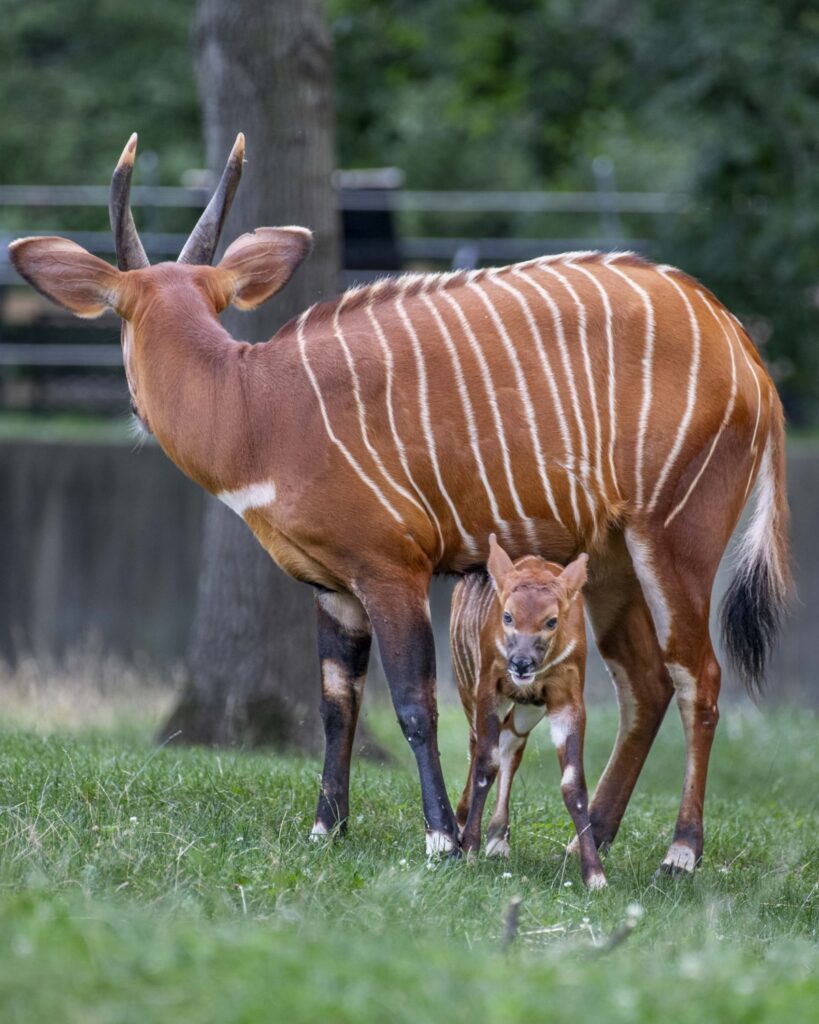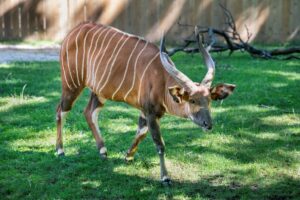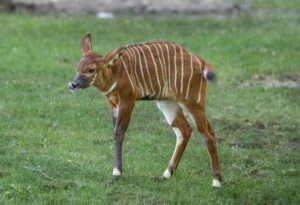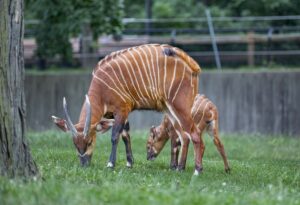
It’s been an exciting time over at the African Forest habitat of the Milwaukee County Zoo, with an adult male and a female calf recently joining the Eastern bongo herd — a Critically Endangered species.
Groot, a 5-year-old male, arrived May 25 from Micanopy Zoological Preserve in Florida. His transfer was facilitated on a breeding recommendation by the Association of Zoos and Aquariums (AZA) Eastern Bongo Species Survival Plan® (SSP). There are less than 100 Eastern (also known as mountain) bongos estimated living in their natural range of central Kenya.

After completing the Zoo’s standard 30-day quarantine, Groot became publicly viewable in the outdoor habitat in early July. He continues to rotate outdoor access on alternating days with the Zoo’s female Eastern bongos: Nyota, 2, Sydney, 13, and Zuri, 14. Bongos’ reddish-brown coat, marked by vertical white stripes, aids in camouflage. Groot can likely be spotted in his favored spot: the back of the outdoor habitat, to the far right, in a shaded area.
Indoors, Groot’s preferred form of enrichment involves a large brush on the wall in his stall in the Impala Barn that’s great for rubbing on. He also enjoys romaine lettuce, a favorite of all the Zoo’s bongos.
The animal care team shares, “Groot is very easy-going. He approaches everything with a calm demeanor, and he’s lovely to work with.”

Meanwhile, another female bongo joined the herd, with Nyota giving birth to a calf on July 7. Nyota was already pregnant when she arrived at MCZ last October from the Dallas Zoo. Because Nyota had never been with a male at MCZ, the animal care team wasn’t checking for signs of pregnancy. As a first-time mother, her pending delivery wasn’t obvious until she went into labor.
The animal care team monitored Nyota’s labor, which was uneventful, and the female calf was born weighing 13 kilograms (28.66 pounds). She was up and walking after about 25 minutes and nursing from Nyota within the hour. The baby, named Nyeri, and Nyota continue to do well, and we’re excited to have this youngest new member of the herd. Nyeri will remain nursing for the next six to eight months and is beginning to nibble on Nyota’s food too. Nyeri is named after a town at the base of the Aberdare Range in Kenya, one of the last wild mountain bongo habitats.

In mid-July, Nyeri was introduced to older females Sydney and Zuri, and she is continuing to follow Nyota, staying close to her. Last week, she was introduced to the outdoor habitat, and guests can now see Nyeri and the other females all together in the Zoo’s African Forest, on alternating days with Groot. (Nyota is the smallest of the group with the shortest horns, while Zuri has crossed horns and Sydney has straighter horns.)
Nyeri’s birth is a particularly welcome occasion, as Eastern bongos are listed as Critically Endangered by the IUCN (International Union for Conservation of Nature). Groot is still recommended for breeding, and he will eventually be introduced to all the females, including the calf, once she’s older. In their natural range, mature male bongos are not typically a “leader” of the herd, tending to be more solitary and joining a group of females temporarily, primarily for breeding purposes. Nyeri is expected to remain here at MCZ.
© 2025 Milwaukee County Zoo. All Rights Reserved | Privacy Policy